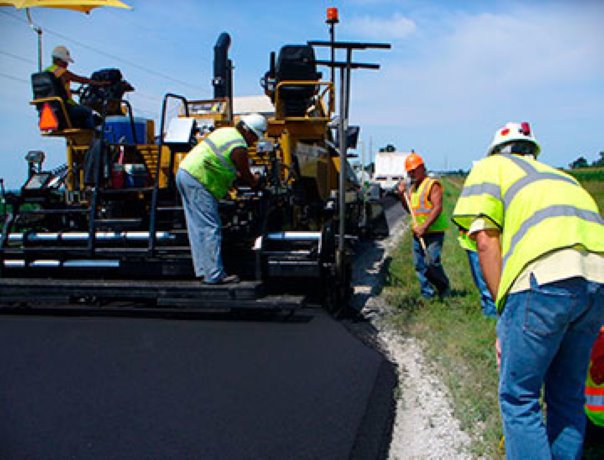A pilot project conducted by the Ontario Ministry of Transportation (MTO) will see three highway paving projects completed using Safety Edge, a 30-degree finished angle designed to improve safety and control at shoulder and road transitions, as compared to vertical or unfinished edges.
Safety Edge is a service mark of the U.S. Federal Highway Administration, which has been promoting the use of the road design across the U.S. The results of preliminary studies suggest that the Safety Edge helps drivers to reduce over-correction and loss of vehicle control on transition. The feature also mitigates tire scrubbing against unfinished edges on road re-entry.
Contractors produce the correct angle at the edge of the pavement using a paving shoe connected to the end gate of the paver screed. The steel wedge is connected so that it floats freely with the end grate, so that the wedge can adapt to variances in shoulder drop-off heights and thicknesses of pavement overlay.
“I’d heard about Safety Edge at a Transportation Research Board conference in Washington, D.C. a few years ago and it seemed promising,” says Susan Nichol, head of Traffic Safety Management with MTO. “We have incorporated that feature into three upcoming Ontario road resurfacing contracts for the 2012 paving season.”
The three projects are Highway 101 north of Kirkland Lake, awarded to Miller Paving; Highway 26 in Stayner, awarded to Georgian Paving & Construction; and Highway 144 north of Sudbury, not yet awarded. The locations were selected based both on collision history and construction timing. All of the projects are two-lane undivided highways with partially paved shoulders.
“Installing the shoe was simple,” says Steve Amer, operations manager with Miller Paving’s northern division. “It involved drilling a couple of holes in the auger extension. After that, it takes only about 10 minutes to bolt the device in or remove it. We’re about halfway through the Highway 101 contract and everything’s going well—we’re meeting the specifications of the contract.”
Nichol notes that, while the design has been shown to improve safety in some U.S. jurisdictions, road performance reports are still largely anecdotal. “We believe that the lack of published data on construction, material performance, and the durability of the tapered edge may be inhibiting the use of the design,” she notes.
Available results from preliminary U.S. studies are difficult to translate to the Ontario environment, simply because paving methods differ across jurisdictions.
“In the U.S., many states don’t necessarily re-grade road shoulders back up to the height of the pavement as we do, or the roads may be subject to erosion or settling issues where the edge of the road is exposed,” she says.
“We will evaluate collision data, but pinpointing it to the design of the road edge may be difficult, due to the relatively small road sample size. Our study will largely look at construction and maintenance implications, including the effect of winter conditions on the edge.”
The cost of implementing the design appears to be standard across jurisdictions; less than one per cent of paving contract costs.
“The effort to achieve the Safety Edge should be almost negligible on the part of the contractor,” says Nichol.
A recent study by the Georgia Department of Transportation (GDOT) focused on the constructability of the Safety Edge along a 21-kilometre asphalt overlay on a rural, two-lane, undivided highway.
GDOT staff developed its own version of the shoe required to produce the edge and compared it to a commercial model supplied by TransTech Systems, Inc. Both designs proved successful and achieved improved smoothness and compaction. The roadside sections completed with a Safety Edge also demonstrated less cracking than the section built using conventional edging techniques.
The MTO tenders offer contractors the choice of three commercially available shoes, or an equivalent product, to complete the contracts. Gravel road shoulders will be graded to bring them up to the height of the paved surface, following resurfacing.
The test projects will undergo visual inspection for a three- to five-year period as part of the assessment and evaluation study.



Recent Comments
comments for this post are closed